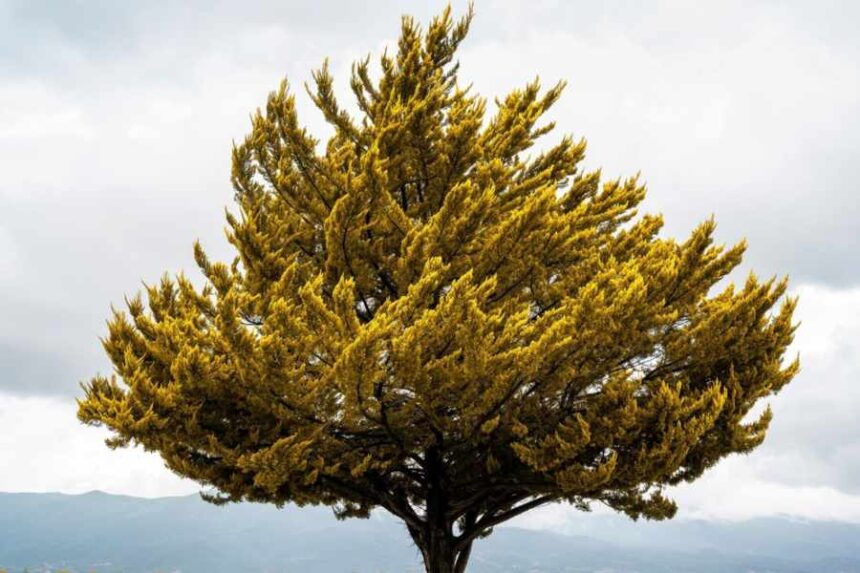If you’ve ever asked yourself, what does a cottonwood tree look like, you’re likely admiring trees with heart-shaped leaves fluttering in the breeze or cotton-like fluff drifting in late spring air. Known for their towering presence and rapid growth, cottonwoods are an essential part of North American landscapes, especially near rivers and wetlands. These deciduous trees are not just beautiful—they also serve critical ecological functions, offering shade, supporting wildlife, and stabilizing soil along waterways.
- In Full Bloom, What Does a Cottonwood Tree Look Like?
- Visual Features That Define Cottonwood Trees
- Leaf Shape and Movement
- Bark Texture by Age
- Tree Height and Canopy Spread
- Seasonal Appearance
- Seed Fluff and Reproduction
- How to Identify a Cottonwood Tree at a Glance
- Why It’s Important to Recognize Cottonwood Trees
- What Does a Cottonwood Tree Look Like in Each Season?
- In Summery
- FAQ’s
Understanding what a cottonwood tree looks like can help you identify it in nature, plant it in your yard, or distinguish it from similar species like aspens or poplars. Whether you’re a nature enthusiast, gardener, or student researching tree species, this guide will offer detailed visuals and characteristics to help you recognize cottonwoods at every stage of their life cycle.
This in-depth article breaks down everything from leaf shape and bark texture to seed dispersal and seasonal changes. By the end, you’ll never have to wonder what does a cottonwood tree look like again—you’ll spot one with confidence.
What does a cottonwood tree look like?
A cottonwood tree has a tall, thick trunk with deeply furrowed bark, broad triangular or heart-shaped leaves with toothed edges, and a cotton-like seed fluff that spreads in spring. It’s commonly found near rivers and grows fast, often towering over 80 feet tall.
In Full Bloom, What Does a Cottonwood Tree Look Like?
Cottonwood trees are truly captivating when in full bloom, especially during late spring and summer. Their broad, triangular or heart-shaped leaves shimmer with every breeze, thanks to their flattened stems, creating a visually striking, almost musical effect. In summer, the leaves are a rich green, offering vibrant contrast against the sky, while in autumn, they transition into brilliant shades of golden yellow, adding to the tree’s seasonal charm and beauty.
Mature cottonwoods display deeply grooved, gray-brown bark that forms thick, rugged ridges, lending a sense of age and strength to the tree’s appearance. Younger cottonwoods, by contrast, feature lighter, smoother bark, making age determination relatively easy on sight. These trees are known for their sheer size, often growing between 80 and 100 feet tall, with wide canopies that cast generous shade.
One of their most recognizable traits is the cotton-like seed fluff released from female trees in late spring. These tufts float through the air and cover the ground in a soft, white layer. Like spotting a creature from a random animal generator, cottonwoods often surprise observers with their distinctive, majestic presence. Paired with an extensive root system that thrives in moist environments, cottonwoods are both visually stunning and ecologically essential.
Visual Features That Define Cottonwood Trees
If you’ve ever asked what does a cottonwood tree look like, understanding its key visual features is essential. From fluttering leaves to cottony seeds, this tree is full of distinctive traits.
Leaf Shape and Movement
One of the most defining features of a cottonwood tree is its distinctive foliage. The leaves are either heart-shaped or triangular and have finely serrated edges. What sets them apart visually is the way they move in the wind. This is due to their unique flat petioles, which allow the leaves to flutter and shimmer with even the slightest breeze, giving the tree a lively, animated appearance during the warmer months.
Bark Texture by Age
Cottonwood bark changes significantly as the tree matures. Young trees display smoother, pale-gray bark that feels soft to the touch. As the tree ages, the bark becomes more rugged and deeply furrowed, shifting into a darker gray-brown shade. These deep grooves and ridges add texture and character, making older cottonwoods easier to identify even in winter.
Tree Height and Canopy Spread
Cottonwoods are some of the tallest deciduous trees in North America, regularly reaching heights of 80 to 100 feet. Their canopies spread wide, creating an expansive crown that offers dense, cooling shade—especially beneficial in riparian and urban environments.
Seasonal Appearance
Throughout the year, cottonwoods exhibit noticeable visual transformations. In spring and summer, their bright green foliage fills out fully, while fall brings a striking shift to golden yellow leaves. During winter, the tree sheds its leaves, leaving behind a bold silhouette and deeply textured bark.
Seed Fluff and Reproduction
Another visual hallmark is the fluffy white seed tufts produced by female trees in late spring. These cotton-like clumps drift through the air, often covering sidewalks and lawns, and are a signature identifier of the cottonwood species.
How to Identify a Cottonwood Tree at a Glance
If you’re out exploring nature and wondering what does a cottonwood tree look like, knowing what to observe can make identification simple. Cottonwoods have several standout features that distinguish them from other deciduous trees, especially in regions near rivers, lakes, or wetlands. Whether you’re hiking, birdwatching, or just curious about your surroundings, this quick guide will help you recognize a cottonwood tree in the wild:
- Leaf Shape and Edges: Cottonwood leaves are large, either triangular or heart-shaped, with finely serrated edges. They tend to shimmer in the wind, giving the tree a lively appearance.
- Bark Texture: Mature cottonwoods have thick, furrowed bark with a rugged gray-brown tone. In contrast, young trees display smoother, lighter-colored bark.
- Tree Height and Structure: These trees are tall and upright, typically growing between 80 and 100 feet. Their trunks are straight, and the canopy spreads widely.
- Seed Fluff: In late spring and early summer, female trees produce fluffy white seed tufts that float through the air—an unmistakable sign of a cottonwood.
- Leaf Movement: Thanks to their flat petioles, cottonwood leaves flutter and twist uniquely in the breeze.
- Habitat: Cottonwoods thrive in moist environments, so you’ll often find them growing along riverbanks, lakesides, or wet lowlands.
Why It’s Important to Recognize Cottonwood Trees
Recognizing cottonwood trees goes beyond simple identification—it has practical and environmental significance. These trees are often planted in reforestation efforts because of their rapid growth and ability to stabilize riverbanks. Their massive canopies provide cooling shade and shelter for wildlife, especially birds and insects.
In landscaping, knowing what does a cottonwood tree look like helps gardeners and property owners make informed decisions. While they grow fast and offer beauty, their roots can be invasive and may not be suitable near foundations or sidewalks.
Ecologists also benefit from identifying cottonwoods, as their presence indicates riparian health. Since they grow primarily in floodplains and wet areas, spotting them can help researchers assess soil moisture and biodiversity. Their distinctive seasonal cycle also makes them an indicator species for climate patterns.
Understanding this tree’s role in your environment—whether urban or rural—gives you deeper insight into local ecosystems. It also empowers homeowners and land managers to balance aesthetics, utility, and ecological responsibility.
What Does a Cottonwood Tree Look Like in Each Season?
Cottonwood trees go through striking transformations throughout the year, offering a unique appearance in every season. If you’re asking what does a cottonwood tree look like at different times of year, here’s what to observe:
- Spring Budding and Catkins: As temperatures warm, cottonwoods begin the season with small green buds that soon develop into long catkins. Female trees produce fluffy white seeds from these catkins later in the season. This soft “cotton” floating through the air is a classic springtime sign of a cottonwood.
- Summer Full Canopy and Seed Fluff: In summer, cottonwoods are lush and vibrant. Their broad, green leaves shimmer in the wind due to their flat stems, creating a constant motion. This is also when cotton-like seed fluff is most visible, often gathering along sidewalks and water edges.
- Autumn Golden Transformation: In the fall, cottonwoods put on a golden show. Their green leaves turn a brilliant yellow, making them stand out dramatically in natural and urban landscapes. Eventually, the leaves drop, leaving a colorful carpet behind.
- Winter Bare but Bold: Even without leaves, cottonwoods remain visually impressive in winter. Their tall trunks and deeply furrowed bark stand strong and rugged against snowy or gray surroundings, making them easy to identify even in dormancy.
In Summery
By now, you should no longer be asking what does a cottonwood tree look like—you should be able to spot one instantly. From the iconic cotton-like seed fluff to the shimmering, triangular leaves and towering height, this tree stands out in North American forests and landscapes.
Whether you’re hiking near a river or planning your backyard garden, recognizing a cottonwood’s unique traits can deepen your connection to nature. It also helps you appreciate the tree’s ecological role and seasonal beauty. Cottonwoods are more than just trees—they’re living markers of changing seasons, water-rich ecosystems, and thriving wildlife habitats.
FAQ’s
What does a cottonwood tree look like in spring?
It starts with budding leaves and catkins. Female trees soon produce white, cottony seed fluff that floats in the air.
How tall can a cottonwood tree grow?
Most cottonwoods grow between 80 and 100 feet tall, making them one of the tallest broadleaf trees in North America.
Are cottonwood trees only found near water?
While they thrive near rivers, creeks, and wetlands, cottonwoods can adapt to various moist soil conditions across many regions.
What kind of bark does a cottonwood tree have?
Mature cottonwoods have deeply furrowed, grayish-brown bark, while younger trees have smoother, light-colored bark.
How can I tell the difference between a cottonwood and a poplar?
Cottonwoods tend to be taller with broader leaves and more pronounced seed fluff, while poplars are generally more compact with narrower leaves.




